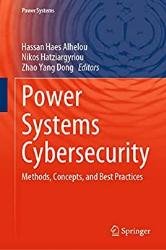 Название: Power Systems Cybersecurity: Methods, Concepts, and Best Practices
Название: Power Systems Cybersecurity: Methods, Concepts, and Best PracticesАвтор: Hassan Haes Alhelou, Nikos Hatziargyriou, Zhao Yang Dong
Издательство: Springer
Год: 2023
Страниц: 463
Язык: английский
Формат: pdf (true)
Размер: 11.8 MB
This book covers power systems cybersecurity.
In order to enhance overall stability and security in wide-area cyber-physical power systems and defend against cyberattacks, new resilient operation, control, and protection methods are required. The cyberattack-resilient control methods improve overall cybersecurity and stability in normal and abnormal operating conditions. By contrast, cyberattack-resilient protection schemes are important to keep the secure operation of a system under the most severe contingencies and cyberattacks. The main subjects covered in the book are: 1) proposing new tolerant and cyberattack-resilient control and protection methods against cyberattacks for future power systems, 2) suggesting new methods for cyberattack detection and cybersecurity assessment, and 3) focusing on practical issues in modern power systems.
Due to environmental concerns and energy security risks, modern power systems are being through the transition toward the smart grid concept, which enables the high penetration level of renewable energies and motilities the high digitalization rate that requires new information and communication infrastructures. Renewable energy resources are mainly inverter-based sources that introduce new problems and technical issues to modern power systems that should be properly addressed. Such energy sources highly decrease the system's total inertia which puts the system's stability and security in danger and weakens the grid against different events including cyberattacks. The main aspect of the transition to smart grids is the replacement of traditional infrastructure that was based on SCADA systems with new ones that are being built based on wide-area measurement systems (WAMS), wide sensor networks (WSN), and internet of things (IoT) technologies. In one hand, the recent advances in the measurements and communications systems, i.e., phasor measurement units (PMUs) and wide-area monitoring systems (WAMSs), open a promising environment for developing new control and protection approaches that can help solve the renewable energy and modern power system operation technical issues. On the other hand, these new infrastructures are vulnerable to cyberattacks which put the system's cybersecurity under the danger, where, in some cases, a small false injected data as an attack could result in a serious blackout.
Cyberattackers are highly skilled professionals working as teams who are capable of generating very complex and coordinated attacks using sophisticated tools. Therefore, power system operators in WAMS centers need to be equipped with robust tools that can detect and classify the cyberattack signals instantly. The WAMS centers should be supplied with new operation, control, and protection approaches that can take cyberattack issues into account. For instance, it is obvious that all control systems in modern power systems should be replaced with new tolerant/resilient controllers against cyberattacks. The new wide-area monitoring systems provide the modern power systems with real-time measurements of electric quantities. Based on these quantities, the power system cybersecurity can be monitored and assessed online and in a real-time manner. Therefore, cybersecurity including the stability and security of modern energy systems can be guaranteed at a suitable level using new wide-area tolerant/resilient control and protection schemes. Developing such schemes can bring several advantages to both the system operators and consumers. Furthermore, this will help in completing the transition to smart grids and adopting new emerging concepts safely, such as demand response programs, virtual power plants, the integration of aggregated electric vehicles (EVs), and other smart appliances with the grid, with no delays due to their high vulnerability to cyberattacks.
This work proposes a self-learning engine which is based on the SPARK data analytics framework and is integrated into a cybersecurity platform. The self-learning module provides the opportunity for annotating data to correct misclassifications or to add intelligence regarding previously unknown attacks. Initially, the domain experts submit annotated data through a Visual Analytics (VA) & monitoring system, to start the retraining process. Three Machine Learning (ML) methods Random Forest (RF), Logistic Regression (LR), and K-nearest neighbors (KNN) - as well as one Deep Learning (DL) method-SDAE - are dynamically compared in terms of F1 - score and accuracy. After the completion of the retraining process, the best-performing model replaces the existing one and labels the incoming data. The dynamic nature of the self-learning module implies that it gets annotations from users anytime, compares the methods during the retraining process, and assigns data labeling to the most accurate model.
Скачать Power Systems Cybersecurity: Methods, Concepts, and Best Practices